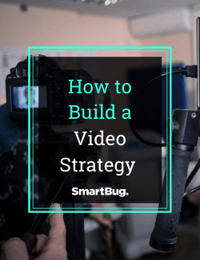
How to Improve Demand Generation with a Creative Video Strategy
September 8, 2021
Whether you’re just starting out with video marketing or you’re a seasoned video marketing pro, there are always ways you can improve your strategies for demand generation. A creative video strategy will keep your brand and products top of mind as video becomes a more popular platform.
In this webinar recap of “How to Improve Demand Generation with a Creative Video Strategy,” we’ll be exploring how you can increase organic traffic, subscribers, conversion rates, views, and the effectiveness of your next video with our panel: Taylor Biggin from Vidyard, Scott Schilling from Brandlive, and Kristina Argiroff from Rybbon.
How do I optimize videos for search?
We already know how important it is to optimize your website for search engines so that your content shows up in search results and is viewed by users, but how can you create those same SEO benefits for the videos you create?
Here are some tips from the panel:
- Create teaser videos that lead to the actual content you want to promote.
- Pre-record a video invite from your featured guests or panelists, so they can share with your network and you can share with yours.
- Provide a text-based rendition of the video. Google can’t interpret the video content on its own, but with a transcript, it can understand what your video is about and when it’s relevant to searchers.
- Utilize structured data. Structured data is the tags in the code that tell search engines when a video is present on a page and what topics the video includes.
- Remove gates from your video. Leads are great, but if your video content is gated, search engines can’t understand the content behind the gate and your video won’t be as easily found in search results.
- Optimize your videos for SEO for top-of-the-funnel content to expose people to your brand.
How can I make videos more inclusive?
Inclusivity in terms of video can mean two things. First, there’s the notion of making sure your video is accessible to those who have disabilities by including things like captions. Utilize a video service that has tools to make sure your video checks all the boxes for web accessibility standards.
However, in terms of making sure your video is inclusive to all people, here’s what our panelists recommend. Biggin recommends making sure a recording of your video is accessible via the internet, so those who may not be in the same time zone or have other obligations during your live event can still choose to watch the content at a later date and on their own time.
Schilling suggests making inclusivity a goal from the beginning of your video. You want to talk to your whole audience, so make sure you’re featuring diverse presenters that come from different backgrounds and have different views about the subject matter. You’ll also want to consider your distribution plan when it comes to making your video inclusive. Make sure you’re promoting the video where your whole audience wants to consume content.
Argiroff also brings the perspective of inclusivity when rewarding users. She says, “You’re going to have viewers all over the world, and everybody values something differently ... You want to be able to provide a thoughtfully curated choice of rewards for whoever is viewing that content.” That way everyone can get the same value from watching your content, no matter where they are in the world.
Where’s the best place to post my video content?
Promotion of your video is imperative to the success of that content, but where is the best place to post your video content? The short answer from Schilling: “Everywhere.”
Schilling then goes on to say if you can’t post it everywhere, try to meet your audience where they are on the internet. This means you need to understand your audience and their preferred channels so you can curate your content to those channels.
There’s also a caveat that you should try to push people to your own channels when possible and when it makes sense. That means publishing your video to both YouTube and your website, but linking to your website rather than YouTube when appropriate.
When it comes to the length of your video and where to post it, Biggin recommends remembering the purpose of your video. He says that yes, your video should be everywhere, but the same video shouldn’t be on each channel. You need to tweak your video to how video is used on each channel.
What are some ways to turn a video into a conversion opportunity?
If demand generation is your ultimate goal of creating videos, how can you allow and encourage users to convert before, during, or after your video? Argiroff says adding a reward could be just the incentive users need to submit a form or keep them engaged in your video.
If your video is supporting your marketing efforts and offers, you can easily layer in an incentive that will help bring in more leads. Communicate the reward upfront and let users know that if they fill out the form, watch the video, and schedule a demo, for example, they will be offered the reward at the end. This same model can even be used to entice current customers to watch new feature videos for upsell and cross-sell opportunities.
Biggin mentions that video is also a great way to aid conversions on landing pages. He also says that embedding the call to action within the video or even turning the video into the lead generation tool by embedding a form into the video that a user has to fill out to continue watching the video with the premium content.
How do I prove the ROI of my video strategy?
This may be the most important question to consider if you’re thinking about starting a video strategy for demand generation. Here are some of the key things to evaluate when proving the ROI of your video strategy.
Start with a plan and purpose. Before ever hitting the record button, you need to have a purpose of what you want to achieve with the video. If demand generation is your goal, you’ll want to include top key performance indicators (KPIs) that reflect that goal. Think about the stage of the funnel you are working on and how you can entice them to next steps. What do you really want people to do after watching your video?
Once you have answers to those questions and you have a clear goal in mind, you need to decide what to track. Common areas to track include:
- Cost per deal or cost per demo (or whatever you decide is your end goal)
- Load-to-view ratio (or the number of times someone saw your video versus how many played your video)
- How long someone watches your video (Biggin says the average watch time should be between 40-60 percent of the total video)
You can keep users engaged by offering rewards for watching the entire video, but make sure you are tracking your success. Argiroff says rewards can help drive the cost per marketing-qualified lead (MQL) down, but you need to keep an eye on the total cost of the MQL, including video production and promotion as well as the cost of the reward you’re offering.
If your video is solely for content marketing and not necessarily for driving conversions, you’ll still want to consider your goals and track a lot of the same metrics to prove your ROI. A holistic content marketing strategy with attribution models that lend more weight to top-of-the-funnel videos could also help prove that ROI.
How can I ensure maximum visibility of my videos?
Once you’ve created the video, how can you make sure people see the content you’ve produced? Ideally, you’ve already come up with a distribution plan for your video in the planning stage.
If you haven’t already, add building a distribution plan to the beginning stages of your video strategy and ask yourself these questions:
- What are my goals for this video? What is the purpose?
- What are the KPIs that best determine the success of this video?
- Where does the intended audience of this video watch similar content?
- What is my budget for this video, including distribution and ad placement?
- Does my budget align with my goals for this video?
- Should I add a reward to watching this video to help cut through online clutter?
How quickly can I get my video strategy up and running?
Many people have the notion that creating video means a long-term project with a large spend and getting additional help from a content agency. While there are times for such productions, your video strategy doesn’t need to start out so extravagant. Biggin recommends starting with smaller scale videos like sales videos and email videos that can add a personal touch and help you close deals.
Schilling argues that if you already have a marketing or content strategy, you already have a video strategy. It’s just a different medium that you can utilize to reach your goals—you just need to start executing. Schilling also recommends aligning your video strategy effort with your expected return.
If you’re looking to start your own video strategy for demand generation, make sure you’re partnering with the right software and platforms. Argiroff says you want to have a platform that’s easy to use, so you can spend less time learning a new product and more time creating video content.
The panel also suggests that if your organization doesn’t have any video yet, start from the bottom of the funnel and work your way up. Creating product demos and explainer videos can help your sales team close more deals and start bringing in revenue sooner.
How long should my video be?
With the short attention span of people in our world today, you might think that the shorter the video the better, but that’s not always the case. Biggin of Vidyard cited Wistia’s “State of Video” report, saying that the majority of videos out there (two-thirds, to be exact) are two minutes or less.
However, the length of your video really goes back to the goals of the video. For example, top-of-the-funnel videos may only be 30-120 seconds long, but as you travel down the funnel a video explaining your features and benefits might be 3-5 minutes or longer, depending on the complexity of your solution. Schilling put it best when he said to line up the length of your video with your user's stage in the funnel and what platform it lives on.
To hear from the experts on improving demand generation with a creative video strategy and hear audience questions and answers, watch the full on-demand webinar.
About the author
Nicole Raymond is an Inbound Marketing Strategist at SmartBug. She's worked in a variety of industries including non-profits, start-ups, and marketing agencies. She has a deep passion for reading and learning and has her Master's Degree in Integrated Marketing Communications. Nicole is compassionate and driven by helping others reach their personal and professional goals. Read more articles by Nicole Raymond.





















